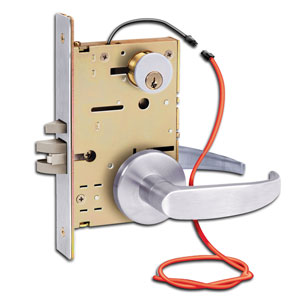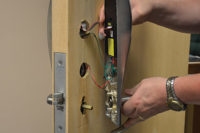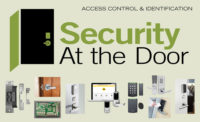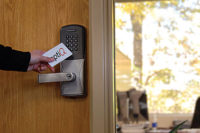
|
| ABOVE: Electrified locksets require cutting into the door, not the frame. Courtesy of Access Hardware |
In the past, integrators and dealers installing an electronic access control stuck to what they knew — electronics — and subcontracted a locksmith to deal with the “hardware” component. Technology, economics and business motivations are changing that, however. More than ever it makes sound business sense in certain cases to take on the complete installation, which means delving into the world of locks. While electric strikes and magnetic locks also need their own knowledge base, electrified locks are one of the most common, and most tricky for the newcomer, to install properly. The good news is that once you get familiar with how to do it, they are pretty simple to do.
At the heart of things, the electrified lockset (and hinge, which is a related and important component) is a means of electrically controlling the door via an access control system. The electrified lockset can be either fail-safe or fail-secure, says Keith Lathrop, business development manager, Midwest Wholesale Hardware, Kansas City, Mo.
“Typically you will have to core the door, which means drilling a hole horizontally through the door from the lockset to the door hinge, which is a raceway for getting the wiring to the door,” he explains. “You have to take a drill bit and drill through the door, which is the biggest concern for most installers. They don’t want to mess up the door.”
Whereas 10 years ago most integrators were subbing out work like this, now they have more motivation to do it themselves and are beginning to get educated, Lathrop adds.
“With the economy the way it is, progressive companies are trying to increase their bottom line,” says J.R. Rollins, sales manager, Access Hardware Supply, San Leandro, Calif. “If they don’t have to pay outside labor or increase the mark-up to make more money, they are in a better profit position.”
Another reason it can be a good idea to install the lock yourself is total control of the project and troubleshooting, if necessary.
“Integrators are starting to appreciate how the locks are an extension of the system,” says Brad Aikin, product manager, commercial electronic security, Schlage (Ingersoll Rand), Carmel, Ind. “There are a lot of things that go on behind the scenes to get a lock to work. And if a lock doesn’t work, the initial gut reaction is that the lock is broken. The reality is probably that there is something wrong between the wiring of the lock and the access control system. If a dealer has an understanding of how that all goes together, they can troubleshoot from beginning to end.”
When to Use Electrified Locksets
With other (equally viable) options out there such as mag locks and electric strikes, how do you know when to use an electrified lockset and why?
In certain applications, the electrified lockset offers some advantages over their counterparts.
“In high security situations you are not cutting into the door frame and compromising the integrity of the opening as far as strength goes,” Rollins says.
Adkins emphasizes aesthetics, saying, “Part of it has to do with a preference on how the door looks, aesthetically. The most common lock is the strike, because it is very simple to install. But the strike is going to require cutting into the door jamb, in contrast to the electrified lock that requires modifying the door. Ultimately they perform similarly, but the electrified lock is more unobtrusive and aesthetically pleasing because it looks like a regular lock.”
This unobtrusiveness may lend it an edge in security, says Michael Phillips, director, brand management, Adams Rite Manufacturing (an ASSA ABLOY company), Pomona, Calif.
“An electrified lockset is concealed within the door and protected,” he says. “If you have a door with a mag lock or electric strike and someone wanted to tamper with it, they can see the components that are electrified. An electrified lockset doesn’t present any differently than a standard door.” The hinge, too, looks just like a regular hinge, plus it conceals the wires from view.
Prepping the Job
What should you do before you install the electrified lockset to make sure the installation goes as smoothly as possible?
“My first tip is to find out what the building standard is,” Rollins says. “What else is on the building?” If you stick with the same type of hardware and a component goes down on a Friday afternoon, you might be able to rob a component off a closet door that doesn’t even lock. Most manufacturers offer electrified counterparts of their non-electrified hardware so it is easier to stay consistent.
“Next is the condition of the opening,” he adds. “Does the door close properly? You can put a $300 lock on a door, but there may be other issues that will make that lock worthless. Also, the door should be self closing. There is no sense in an expensive lock if the door isn’t going to close, so you want to put a closer on there as part of the package.
“And probably the biggest tip of all is to make sure the lock is really going to retrofit onto what is there. We recommend that the dealer take pictures and measurements to make sure we get the right product to them.”
Lathrop also recommends a close inspection when retrofitting. “Make sure you know what is under that lock. You could have a mechanical combination lock on that door. When you pull that off you will have holes you have to cover. There is hardware made for that and it is simple to install, but you need to document that up front when you are estimating the job so you have an accurate accounting of your projected costs. Also know what type of door frame you will be dealing with. Proper planning and proper training prevents surprises.”
Don’t forget about the hinges, Phillips adds. “That is another issue for a proper site survey. Know what products are already there. A door has to swing a certain way and be set up with a door closer and hinges. You can’t just throw in any hinge. Most hinge manufacturers have the exact electrified versions of their mechanical hinges. It is usually a one-for-one trade-out.”

|
|
It is important to make sure the wired hinges match the ones that they are replacing. Most manufacturers have a like-to-like replacement. Courtesy of Schlage (Ingersoll Rand) |
Installation Tips and Tricks
You have walked the job, spec’d the product and have everything ready to go. What should you watch out for in the installation itself?
“The first thing you need to know is what kind of lock it is, mortise or cylindrical, and have the basic tools for that,” Rollins says. “Beyond that, make sure you have all the parts you need before you take that door and lock apart. The biggest thing that happens when you take a lock apart is that there may be a problem with that lock and there is a good chance that it will be destroyed in the process of taking it off.”
Aikin recommends using drilling templates. “Most manufacturers provide some type of template in the box with the lock. But above and beyond that, many third parties sell a mounting jig that has holes drilled in that you can clamp to the door. That is very useful if you are doing a high volume of doors. One of the most common issues we have seen is the importance of drilling holes straight through, parallel to the ground and not at an angle. That can lead to alignment issues.”
Pay close attention to the wiring, adds Jim Lee, president, JLM Wholesale, Oxford, Mich. “Proper wiring and following the diagrams is the best advice I could give an installer. Typically when we field technical help calls it is often a wiring issue. From an installation standpoint, it is not just a matter of cutting, etc. It always comes back to proper wiring.”
The key thing, Lathrop concludes, is to get trained on installing the locks and feel comfortable. “Once you really learn how to core the door and you have the proper tools in hand, it is really a very easy process. Electrified locks are very reliable if installed properly.”
Know the Code
As in any job that involves locking doors, no matter what technology is used, electrified locks are subject to fire code issues and must be cleared with the local Authority Having Jurisdiction (AHJ).
“Checking with the AHJ should be right up there with what to do first,” says J.R. Rollins, sales manager, Access Hardware Supply. “It’s not rocket science, but common sense sometimes goes out the window when the customer provides you a theory of operation that doesn’t make sense — like locking both sides of the door. If you pull in the AHJ before you throw a lock at it, they will tell you what is needed and save that customer money in the long run.
Fire codes are always key to be aware of in door lock installation, says Keith Lathrop, business development manager, Midwest Wholesale Hardware. “If your door is a fire door, when you drill through it you have voided the UL listing on that door. You can take classes through manufacturers to get certified on the proper way of doing it so that door can be relisted under UL.”
Beyond fire codes, there is a growing demand for electrified locks to be viewed as part of the overall electronic system and not a separate hardware lock, says Brad Aikin, product manager, commercial electronic security, Schlage. Currently UL1054 is the most commonly applied code for electronic locks, but it applies chiefly to hardware locks. UL 294 is the listing for electronic access control equipment and a code that will increasingly be applied to electrified locks going forward.
“In the past electronic locks were viewed as hardware and not considered part of the overall solution. Many were sold based on mechanical locking codes. But the reality is these devices communicate to the electronic access control system and should be viewed the same as a fire alarm or access control panel. We should start to see higher specs driving that.




